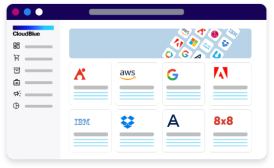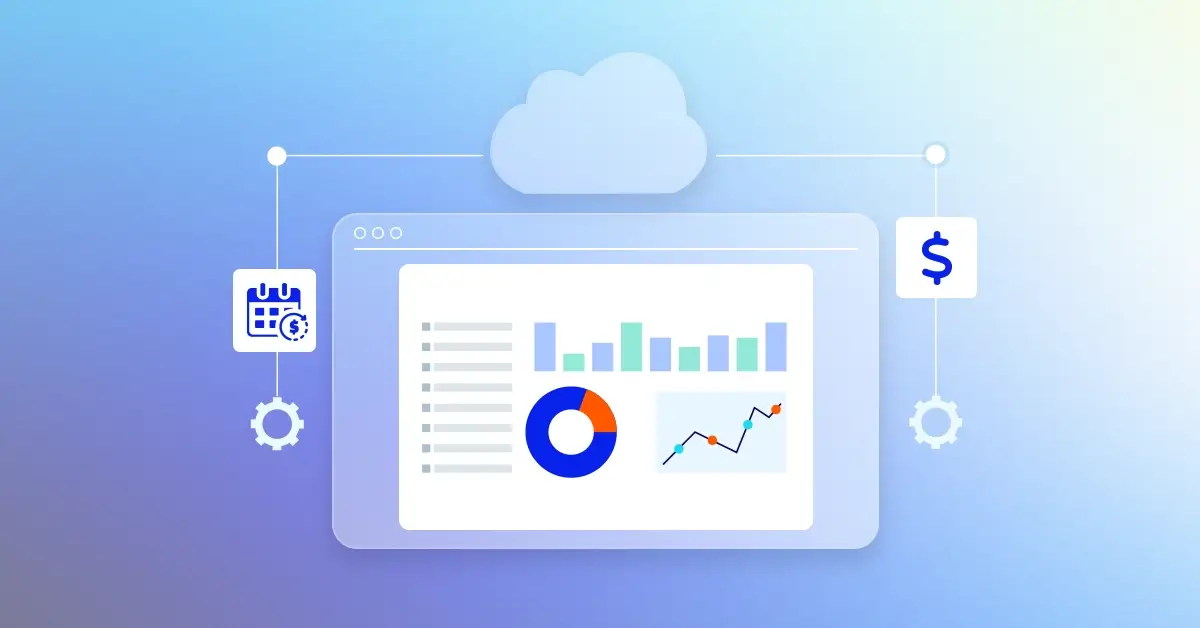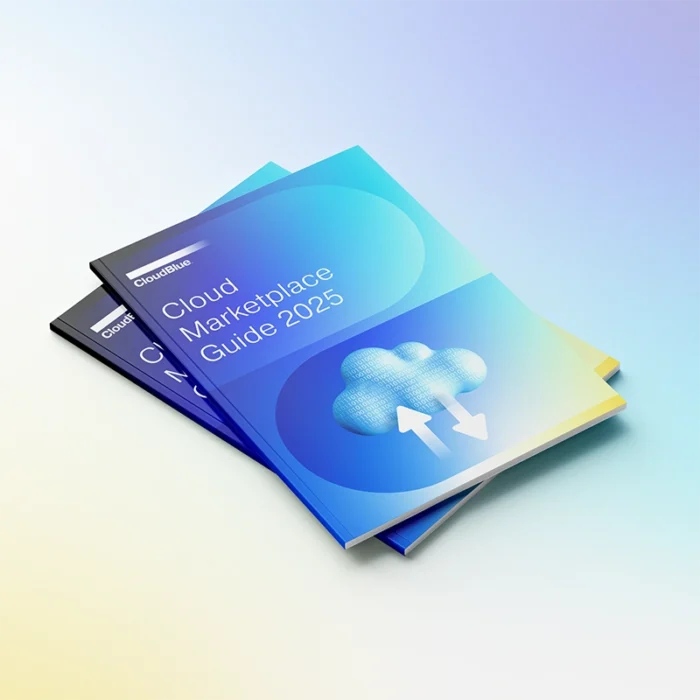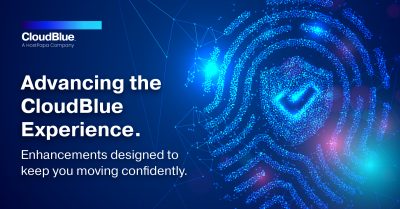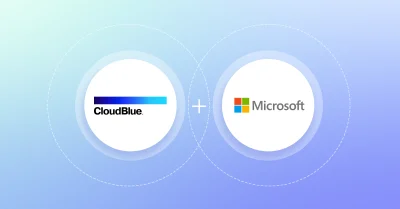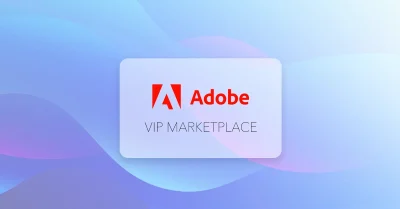Introduction
Optimizing subscription management is critical for staying competitive in today’s fast-paced business environment. SaaS Subscription Management Software automates vital processes such as subscription sign-ups and invoicing, boosting operational efficiency.
As businesses increasingly pivot to SaaS subscription models, robust subscription management tools become indispensable. This software not only enhances customer interactions but also provides actionable insights through advanced analytics and seamless integrations.
This article explores essential features to consider when evaluating SaaS Subscription Management Software. From flexible subscription plans to automated billing systems, each feature contributes to a streamlined subscription management strategy.
Whether you’re exploring options or refining existing processes, understanding these features empowers strategic decision-making that matches your business goals.
1. Subscription Lifecycle Management
Choosing the right SaaS subscription management platform is essential for effectively managing the subscription lifecycle. Critical features such as flexible subscription plans and versatile pricing structures can significantly enhance customer satisfaction, streamline operations, and optimize revenue streams. Ensuring your platform supports these capabilities is crucial for meeting diverse customer needs and maintaining business agility. Here’s a breakdown of key features to look for when selecting your subscription software solution:
- Customizable Time Cycles: Ensure the software supports various subscription durations such as monthly, quarterly, semi-annual, and annual cycles to accommodate customer preferences.
- Tiered Pricing Structures: Look for tools that enable you to create different pricing levels with varying features or usage limits, allowing you to cater to different customer segments effectively.
- Discounts, Promotions, and Coupons: Choose software that simplifies the management of discounts, promotional offers, and coupon codes. This capability helps attract new customers and retain existing ones through strategic pricing strategies.
- Trial Periods: The software should provide options for offering free trials or discounted introductory periods. This feature allows potential customers to experience your service with minimal risk, encouraging conversion.
- Upgrade and Downgrade Flexibility: Ensure subscribers can easily upgrade to higher-tier plans or downgrade to lower tiers as their needs change. This flexibility enhances customer satisfaction and reduces churn rates.
- Prorated Charges: Look for software subscription platforms that calculate charges proportionally based on subscription changes. This ensures fair billing practices when subscribers upgrade, downgrade, or make changes mid-cycle.
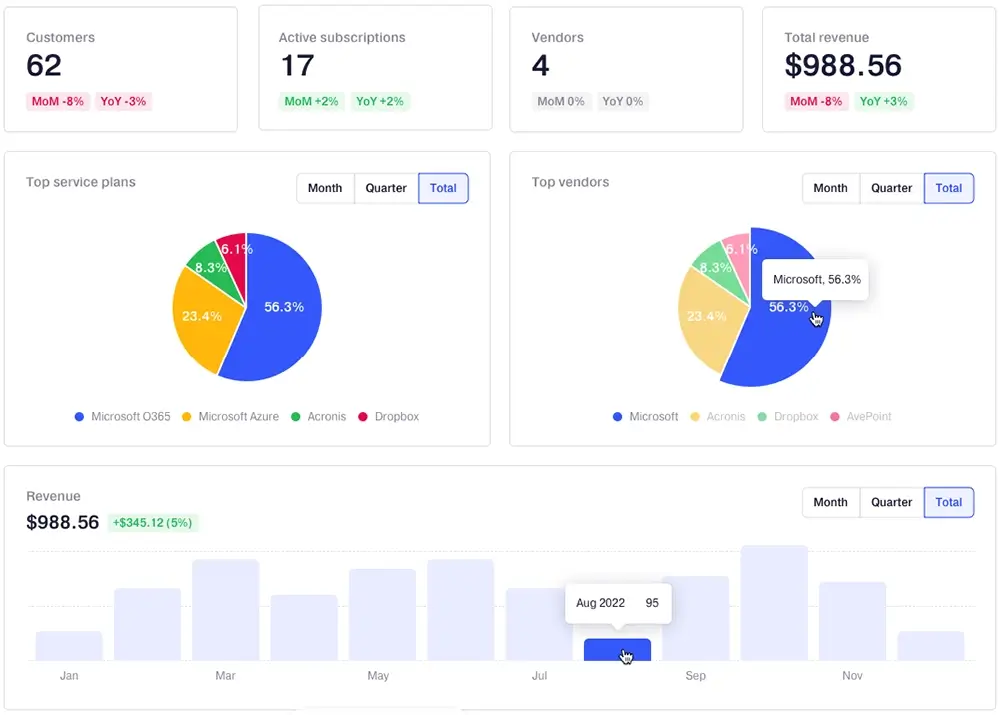
2. Analytics and Reporting
In the competitive world of SaaS, data-driven decision-making is essential. Analytics and reporting capabilities in subscription management software provide valuable insights that can drive business strategy, optimize operations, and enhance customer satisfaction. Here are the critical features to consider:
- Real-Time Reporting: The software should offer real-time reporting capabilities, allowing you to monitor key metrics as they happen. This immediacy helps in making timely decisions and responding quickly to any emerging trends or issues.
- Customizable Dashboards: Look for tools that offer customizable subscription management dashboards, enabling you to display the most relevant data at a glance. This personalization ensures that different team members can focus on the metrics that matter most to their roles.
- Revenue and Growth Metrics: The software should provide detailed insights into revenue streams, including monthly recurring revenue (MRR), annual recurring revenue (ARR), and customer lifetime value (CLTV). Understanding these metrics is crucial for tracking growth and identifying expansion opportunities.
- Churn Analysis: Churn rate is a critical metric for subscription-based businesses. The software should offer robust churn analysis tools, helping you identify patterns and causes of customer attrition. These insights can inform strategies to improve retention and reduce churn.
- Customer Segmentation: Advanced subscription analytics software should enable customer segmentation based on various criteria such as usage patterns, subscription plans, or geographic location. This segmentation allows for more targeted marketing efforts and personalized customer experiences.
- Cohort Analysis: Cohort analysis helps in understanding the behavior of specific groups of customers over time. This analysis can reveal trends in customer engagement, retention, and revenue, guiding strategies to improve long-term performance.
- Predictive Analytics: Look for software that incorporates predictive analytics to forecast future trends based on historical data. Predictive insights can help in planning marketing campaigns, anticipating customer needs, and optimizing resource allocation.
- Operational Metrics: Beyond financial and customer data, the software should track operational metrics such as billing efficiency, support response times, and service uptime. Monitoring these metrics ensures that operational performance remains high.
- Scheduled Reporting: Automated, scheduled reports delivered via email can keep key stakeholders informed without the need for manual data extraction. This feature ensures that everyone stays updated with the latest performance metrics.
3. Integration Capabilities
In the interconnected landscape of modern business, integration capabilities are essential for SaaS subscription management software. Seamless integrations with other systems enhance operational efficiency, data accuracy, and overall business performance. Here are the critical integration features to consider:
- CRM (Customer Relationship Management) Integration: The software should integrate with popular customer relationship management (CRM) systems like Salesforce, HubSpot, or Zoho. This connection ensures that customer data is synchronized across platforms, providing a unified view of customer interactions and improving sales and support processes.
- Accounting and Financial Systems: Integration with accounting and financial software such as QuickBooks, Xero, or NetSuite streamlines financial management. Automated synchronization of billing, invoicing, and payment data reduces manual entry, minimizes errors, and simplifies financial reporting and reconciliation.
- Payment Gateways: Support for multiple payment gateways like PayPal, Stripe, and Square is crucial. This flexibility allows customers to choose their preferred payment method, enhancing their experience and ensuring smooth transactions.
- Marketing Automation Tools: Connecting with marketing automation platforms like Mailchimp or Marketo, can help streamline marketing efforts. Synchronizing customer data enables personalized marketing campaigns, targeted communications, and improved lead nurturing.
- Customer Support Systems: Integration with customer support tools like Zendesk, Freshdesk, or Intercom enhances support operations. Unified customer data enables support teams to provide more efficient and personalized assistance, improving customer satisfaction.
- ERP Systems: For larger organizations, integration with enterprise resource planning (ERP) systems such as SAP, Oracle, or Microsoft Dynamics is essential. This connection ensures seamless data flow across the entire business ecosystem, from procurement to production and distribution.
- Cloud Marketplace Integration: If your business involves offering software products through a subscription website, integrating with cloud marketplace platforms like AWS Marketplace, Google Cloud Marketplace, or Microsoft Azure Marketplace is highly beneficial. This integration ensures that your product data and customer information are synchronized across multiple platforms, expanding your reach, and improving the overall customer experience.
- Data Analytics Tools: Integration with data analytics platforms such as Google Analytics, Tableau, or Power BI enables deeper insights into customer behavior, subscription trends, and financial performance. These insights inform strategic decision-making and drive business growth.
- API Availability: The software should offer robust APIs for custom integrations. This flexibility allows businesses to connect with niche tools or internal systems, ensuring that the subscription management system fits seamlessly into their unique workflows.
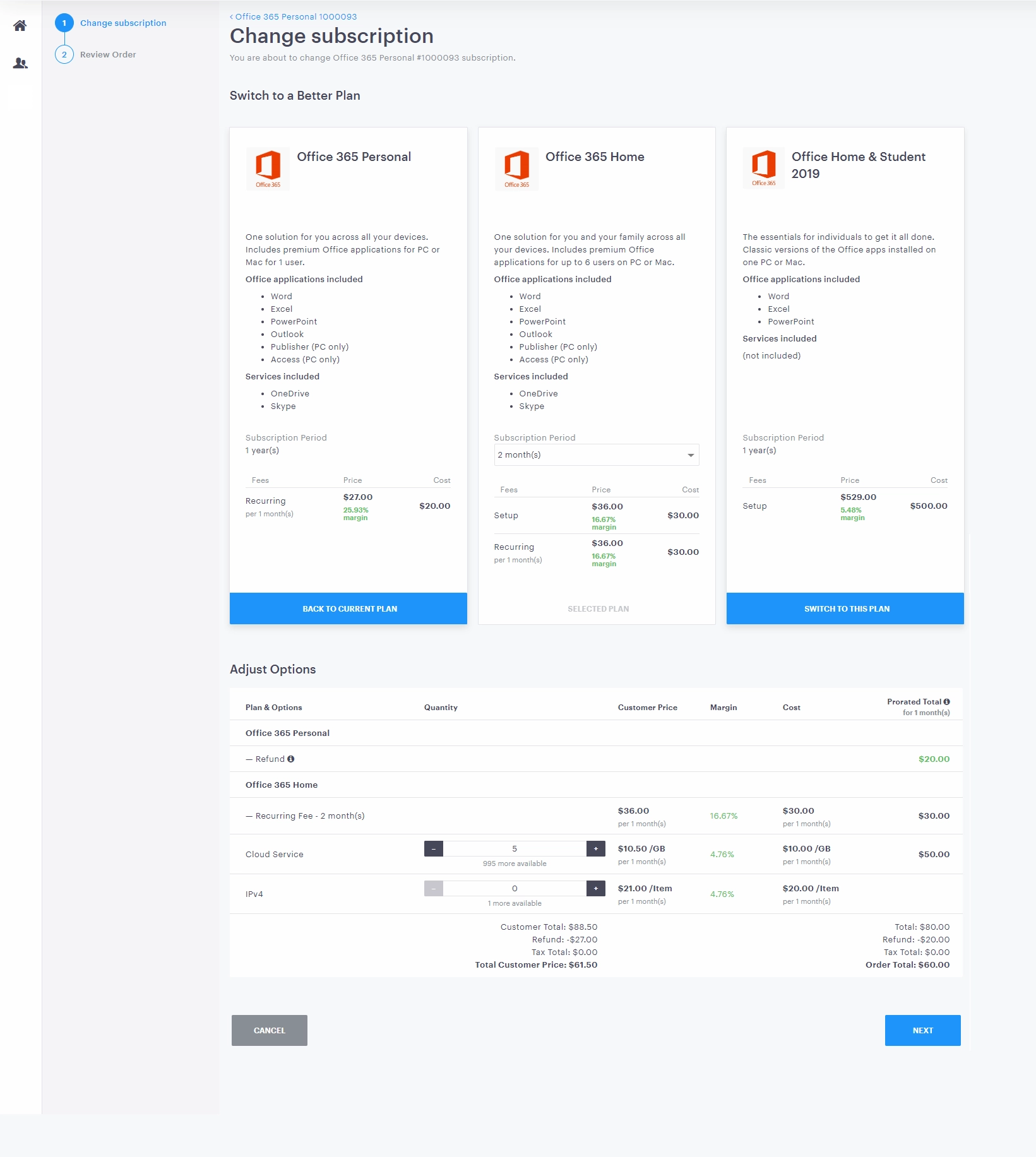
4. Customer Self-service Portal
A customer self-service portal is a critical feature of SaaS subscription management apps, offering users the ability to manage their subscriptions independently. By empowering customers with self-service capabilities, businesses can enhance customer satisfaction, reduce support costs, and streamline operations. Here are the key aspects to consider:
- Account Management: The portal should allow customers to update their personal and billing information, manage payment methods, and view their subscription status. This transparency builds trust and reduces the need for customer support interactions.
- Subscription Modifications: Customers should be able to upgrade or downgrade their subscription plans, add or remove services, and make other adjustments as needed. This flexibility ensures that customers can tailor their subscriptions to their changing needs without requiring manual intervention.
- Billing and Payment History: Providing access to past invoices and payment receipts helps customers keep track of their financial transactions. This feature also reduces the volume of billing-related queries directed at customer support teams.
- Support and Resources: The portal should include access to help articles, FAQs, and other resources to assist customers in resolving common issues independently. Integrating a ticketing system or chat support can further enhance the self-service experience.
- Usage Monitoring: For services with usage-based billing, the portal should display real-time usage data and alerts for nearing limits or overages. This transparency helps customers manage their usage more effectively and avoid unexpected charges.
- Cancellation and Renewal Options: Simplifying the process for subscription cancellations and renewals empowers customers to make these decisions without friction. Clear options and easy workflows reduce frustration and help maintain positive customer relationships.
- Security Features: Ensure the portal includes robust security measures, such as two-factor authentication and encryption, to protect sensitive customer information and maintain data privacy.
5. Scalability and Customization
Scalability and customization are crucial for SaaS subscription management software, ensuring that the subscription commerce platform can grow with your business and adapt to its unique needs. A scalable solution supports increasing customer bases and evolving business models, while customization ensures the software aligns with your specific processes and requirements. Here are the key features to consider:
- Flexible Architecture: The software should have a flexible and modular architecture that can handle increasing volumes of data, users, and transactions. This scalability ensures that the system remains efficient and responsive as your business grows.
- Customizable Workflows: Look for tools that allow you to customize workflows to match your business processes. Customizable workflows ensure that the software can adapt to your specific operational needs, improving efficiency and user satisfaction.
- User Roles and Permissions: The software should support detailed user roles and permissions, allowing you to control access to different features and data. This customization enhances security and ensures that users have the appropriate level of access based on their roles.
- Custom Fields and Data Attributes: The ability to create custom fields and data attributes is essential for capturing unique information relevant to your business. This feature allows you to tailor the software to your specific data requirements.
- Multi-Tenant Capabilities: If you manage multiple brands or business units, multi-tenant capabilities are important. This feature allows you to segregate data and manage subscriptions for different entities within a single platform.
- Custom Reporting: The software should offer customizable reporting options, allowing you to generate reports that meet your specific analytical needs. Custom reporting ensures that you can extract the most relevant insights for your business.
- Localization and Language Support: If you operate in multiple regions, the software should support localization and multiple languages. This feature ensures that the platform can cater to the needs of a global customer base.
- Performance and Reliability: Scalability is not just about handling more users but also ensuring consistent performance and reliability. The software should maintain high-performance levels even as your user base grows, ensuring a smooth experience for all customers.
- Customizable Catalog Management: The software should allow you to easily manage and customize your product catalog, including adding, modifying, and organizing products and services. This flexibility ensures that you can efficiently update offerings and tailor them to different customer segments or market demands.
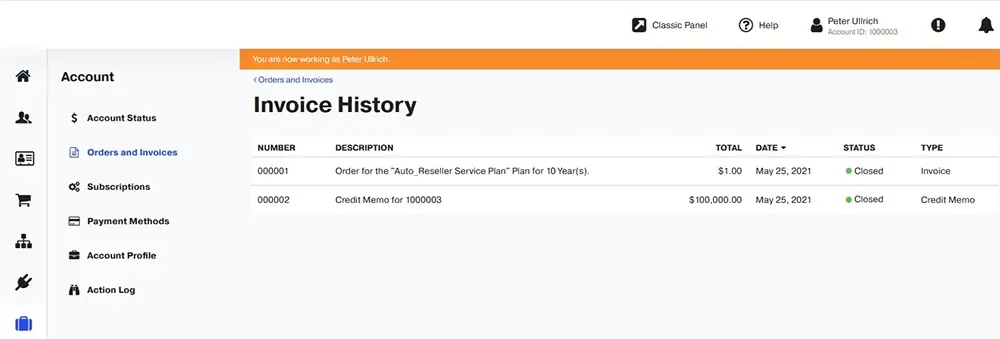
6. Automated Billing and Invoicing
Efficient and accurate billing is fundamental for maintaining customer trust and ensuring smooth financial operations. Automated billing and invoicing features in SaaS subscription management software simplify the entire billing process, reduce manual errors, and save valuable time for your finance team. Here are the key elements to consider:
- Recurring Billing Automation: The software should support automated billing cycles, handling recurring payments seamlessly. This reduces the manual effort required for generating invoices and ensures timely payments, enhancing cash flow and operational efficiency.
- Multiple Payment Gateways: Ensure the software integrates with various subscription payment gateways, allowing customers to choose their preferred payment methods. This flexibility can improve customer satisfaction and reduce payment-related issues.
- Customizable Invoicing: Look for tools that offer customizable invoice templates, allowing you to include your branding, terms and conditions, and other relevant information. Personalized invoices enhance the professional image of your business.
- Dunning Management: Effective dunning management features help manage failed payments and reduce churn. Automated reminders and retry mechanisms can help recover failed transactions and keep your revenue stream steady.
- Tax Compliance: The software should handle tax calculations based on different regions and tax laws, ensuring compliance with local regulations. Automated tax management reduces the risk of errors and simplifies financial reporting.
- Multi-Currency Support: If your business operates globally, multi-currency support is crucial. The software should manage billing and invoicing in various currencies, accommodating international customers and simplifying global transactions.
- Payment Reminders: Automated payment reminders for upcoming or overdue invoices help ensure timely payments. This feature reduces the burden on your finance team and improves cash flow management.
7. Revenue Recognition Management
Accurate revenue recognition is vital for compliance with accounting standards and for providing a true picture of your financial health. SaaS subscription management software with robust revenue recognition features ensures that revenue is reported correctly, aligning with industry regulations and financial best practices. Here are the key features to consider:
- Compliance with Accounting Standards: The software should comply with major accounting standards such as ASC 606 and IFRS 15. This compliance ensures that revenue is recognized per regulatory requirements, reducing the risk of financial discrepancies.
- Automated Revenue Allocation: Look for tools that automatically allocate revenue over the subscription period. This feature ensures that revenue is recognized accurately over time, matching the delivery of services to the billing period.
- Deferred Subscription Revenue Management: The software should handle deferred revenue effectively, tracking amounts that have been billed but are not yet recognized as revenue. Proper management of deferred revenue is essential for accurate financial reporting and cash flow management.
- Multi-Element Arrangements: For businesses offering bundled services or products, the software should support multi-element arrangements. This capability allows for the allocation of revenue across different components, ensuring accurate and compliant revenue recognition.
- Customizable Revenue Rules: The software should offer flexibility in defining revenue recognition rules based on your subscription business model. Customizable rules ensure that revenue is recognized in a way that aligns with your specific contractual obligations and service delivery.
- Revenue Forecasting: Advanced revenue recognition tools should include forecasting capabilities. Predicting future revenue based on existing subscriptions and historical data helps in strategic planning and financial management.
- Real-Time Revenue Reporting: Access to real-time revenue data allows for immediate insights into financial performance. This transparency aids in timely decision-making and ensures that stakeholders have up-to-date information.
- Audit Trails: The software should provide detailed audit trails for revenue transactions. This feature is crucial for ensuring transparency and accountability, making it easier to trace and verify revenue entries during audits.
- Comprehensive Financial Reports: Look for software that generates detailed financial reports, including income statements, balance sheets, and cash flow statements. These reports provide a complete view of your financial health and aid in regulatory compliance.
Final Thoughts
Selecting the best subscription management software is a pivotal decision that can shape your business’s efficiency, customer satisfaction, and growth trajectory. By focusing on the essential features outlined in this article, you can make an informed choice that aligns with your strategic objectives.
By prioritizing these 7 features, you can streamline your subscription management processes, enhance customer experience, and drive business growth. The right software will not only support your current operations but also provide the flexibility and scalability needed to adapt to future challenges and opportunities.
As you evaluate different options, consider how each feature aligns with your business model, goals, and operational requirements. Investing in a robust SaaS subscription management service is an investment in your business’s future, ensuring sustained success and competitive advantage in the fast-paced SaaS industry.

